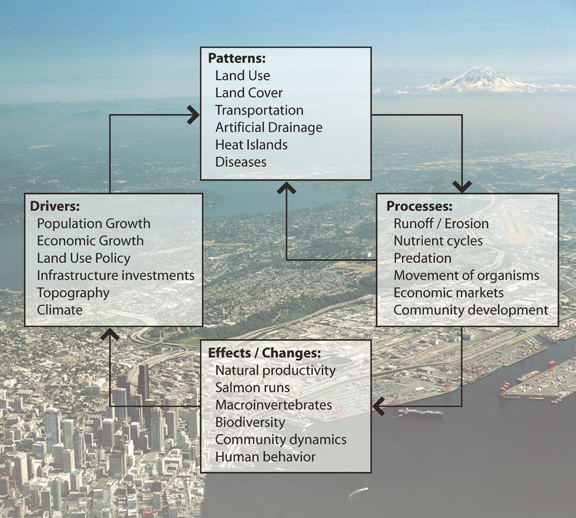
Urban landscape patterns are emergent, coupled human-natural phenomena that epitomize the complexity of interactions and feedback mechanisms between human decisions and ecological processes. The process of urbanization results in a complex pattern of intermixed high- and low-density built-up areas and fragmented natural patches. Alternative urban development patterns affect ecological processes both directly—by replacing native habitat with simplified, human-dominated systems—and indirectly—by rearranging the biophysical attributes that cause a variety of interrelated local and global effects.
Detecting Ecological Signatures of Development Patterns
Urban landscape patterns are emergent, coupled human-natural phenomena that epitomize the complexity of interactions and feedback mechanisms between human decisions and ecological processes. The process of urbanization results in a complex pattern of intermixed high- and low-density built-up areas and fragmented natural patches. Alternative urban developme
nt patterns affect ecological processes both directly—by replacing native habitat with simplified, human-dominated systems—and indirectly—by rearranging the biophysical attributes that cause a variety of interrelated local and global effects. To test formal hypotheses about the mechanisms that link urban landscape patterns to ecosystem dynamics, we have started to empirically quantify and discriminate patterns of urban landscapes associated with a series of biophysical and socio-economic variable across a gradient of urbanization. The landscape signatures of development patterns are quantified using selected landscape-pattern metrics that describe four dimensions of landscape pattern that have been found significant to predict ecosystem function: form, density, heterogeneity, and connectivity. The research team has developed a high resolution data base that combines satellite imagery time series and land use parcel to characterize and model land cover change.
Past projects:
Alberti, M. 2007. Ecological signatures: The science of sustainable urban forms. Places. 19(3): 56-60.
Carbon Signatures of Development Patterns along a Gradient of Urbanization